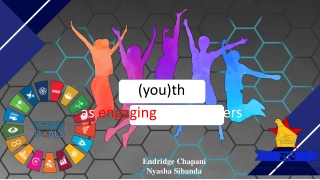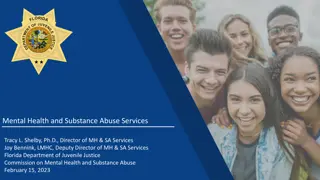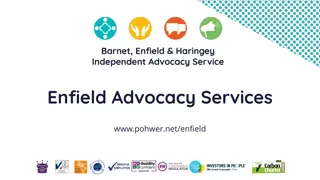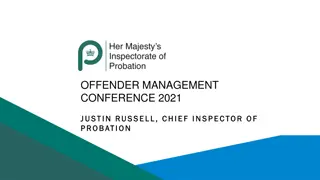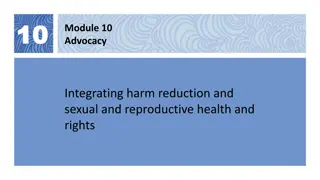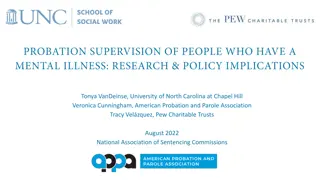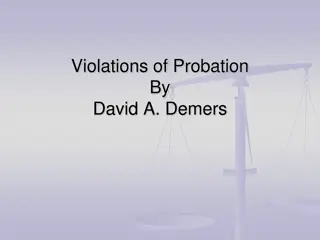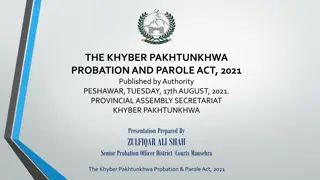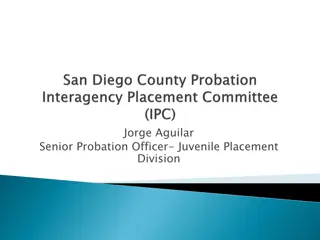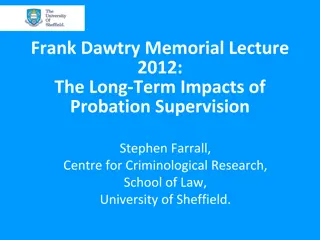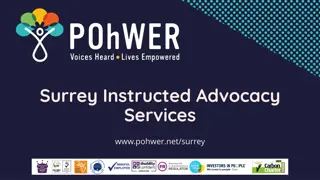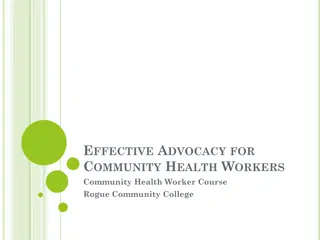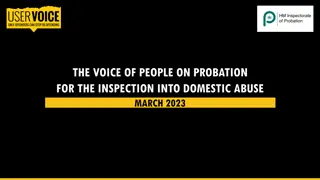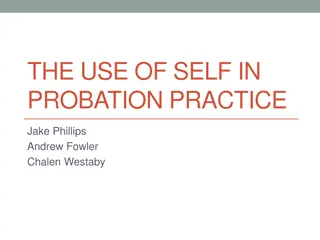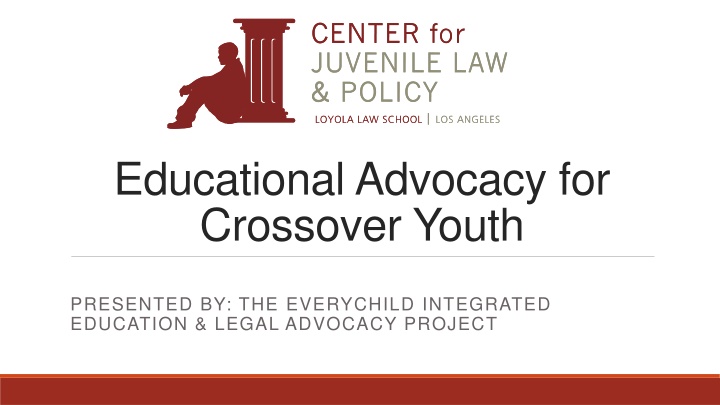
Educational Advocacy for Crossover Youth and the School-to-Prison Pipeline
"Explore the challenges faced by crossover youth, the reasons foster youth cross over, and the detrimental impact of the School-to-Prison Pipeline. Learn about educational advocacy, special protections, and support mechanisms for these vulnerable youth populations."
Download Presentation

Please find below an Image/Link to download the presentation.
The content on the website is provided AS IS for your information and personal use only. It may not be sold, licensed, or shared on other websites without obtaining consent from the author. If you encounter any issues during the download, it is possible that the publisher has removed the file from their server.
You are allowed to download the files provided on this website for personal or commercial use, subject to the condition that they are used lawfully. All files are the property of their respective owners.
The content on the website is provided AS IS for your information and personal use only. It may not be sold, licensed, or shared on other websites without obtaining consent from the author.
E N D
Presentation Transcript
Educational Advocacy for Crossover Youth PRESENTED BY: THE EVERYCHILD INTEGRATED EDUCATION & LEGAL ADVOCACY PROJECT
Presentation Overview o Background o Educational advocacy for crossover youth o Special protections for foster and probation youth o School of Origin o Immediate Enrollment o Partial Credits o AB 167/216 o School Discipline o Special Education
Crossover Youth o Young people who come into contact with both the juvenile dependency system and the juvenile delinquency system oVery common for youth in the juvenile dependency system to cross over to the juvenile delinquency system for committing a crime or other infraction o Around 30% of foster youth will cross over into the juvenile delinquency system oA majority of youth in juvenile delinquency system have previous contact with the child welfare system o One recent national study found that over 90% of probation youth had previous contact with the child welfare system o An LA County-focused study showed that 4/5 of probation youth in suitable placement or camp had previous contact with the child welfare system o Previous contact=at least one referral o Average number of referrals=5.6
Why do foster youth cross over? o Unaddressed and misunderstood trauma, mental health needs, and other diagnoses oLeads to acting out and other problematic coping mechanisms that are criminalized (substance abuse issues) oYouth that change homes can struggle to obtain regular and appropriate mental health care and medication management o Criminalization of normal adolescent behavior oEspecially a problem in group homes o Negative peer influences and a desire to belong o The School to Prison Pipeline
The School to Prison Pipeline o Defined: when children who get into trouble at school or struggle at school are funneled into the juvenile justice system o How? o Youth may break school rules and the school passes along the issue to the police o Now that many local schools have their own resource officers, even more common o Youth who are subject to out of school discipline (e.g., suspension or expulsion) end up getting in trouble without adequate supervision o Youth who are informally pushed out of school to alternative school placements that don t meet their needs o Why foster youth? o Unaddressed special education needs o Negative associations with school and/or peer relation issues due to constant school moves o Lack of a strong parent advocate to fight to protect a youth s rights o Once youth become involved in the juvenile justice system, a vicious cycle can start o Terms of probation require good grades, attendance, no fights, etc. but youth often still don t have advocates to ensure they get services they need, so they remain on probation and lose hope o Youth on probation are discriminated against: denied enrollment in school, carefully monitored by school personnel to catch any mistake
Education Rights Holders o California law: every child under the juvenile or dependency court s jurisdiction must have an individual that serves as their Education Rights Holder (ERH). o Having an active and involved ERH is key to educational success for crossover youth and to prevent or minimize impacts of school to prison pipeline. o ERHs make decisions about: o School enrollment o Graduation options o Special Education o School discipline
Who can be an Education Rights Holder? Automatic: Sometimes: Never: o biological parents o relatives o social worker o adoptive parents o caregivers o probation officer o legal guardians o foster parents o group home staff o youth when they turn 18 o mentors o attorney o Court Appointed Special Advocates (CASAs) o school staff o therapist
Changing Education Rights o When? oIf youth s current ERH is not available, not responsive, or acting against the youth s interests o How? oYouth s attorney in in dependency or delinquency court can ask the court for a change o What else? oThink about this when a youth is changing placements (especially from one foster home to another) oConsider who would be the best to serve in this role (who knows the youth well and will be a continued presence in their life?) o There can be two ERHs at one time
Foster and probation youth-special protections o Why do extra rights exist for these youth? oCourt-involved youth face unique challenges o They move homes often o They change schools often o Every time a youth moves, studies show they lose 4-6 months of academic progress o They miss lots of school for court, counseling, doctors visits, etc. o They often have poor education outcomes for all of these reasons AND more o Who is eligible? o All youth with an open foster care court case o All youth with an open delinquency court case o How do you enforce these laws? o You can file a compliance compliant with the California Department of Education to make sure schools are doing right by these youth
What is a School of Origin (SOO)? o Youth may continue attending (or return to) a school as their SOO even after moving homes if it is in their best interest. oWhat is a SOO? 3 definitions: The school the youth was attending when their dependency or delinquency case opened The school the youth most recently attended Any school the youth attended in the last 15 months to which they felt a connection But what about transportation? Caregivers (but not biological parents) entitled to reimbursement Ask DCFS social worker or probation officer Group homes should provide Federal law requires transportation plans (interim plan in place in LA County) Ask the youth s school district about how they can be transported
What else to know about SOO o Every time a youth is potentially changing placements, DCFS and probation must consider school stability o When a move that would change the youth s school is going to occur, youth, youth s attorney, and youth s ERH must be notified oIf there is a dispute about SOO, the youth has a right to remain in the SOO pending a hearing o This law applies to all public schools including comprehensive, magnet, charter, and alternative schools oEven applies to charter schools with a lottery system
Immediate Enrollment o Foster and probation youth have the right to attend their local comprehensive school oSchools cannot keep youth from enrolling because they re on probation or have just been released from camp! oThey must be enrolled in the SAME or EQUIVALENT classes that they were taking at their last school (not all elective classes!) o To make transition smooth o To decrease loss of learning from move o To help them graduate o Less than 60% of foster youth graduate from high school in the state of CA, this law is intended to help make this number better! oThey may immediately enroll (immediate=immediate) o No matter when they seek to enroll during the school year o Without documents normally required for enrollment o Transcripts, immunization records, etc. o Unless they ve been expelled from this school or are under an expulsion order
Alternative Schools o Foster and probation youth cannot be forced to attend an alternative school o Even though districts are more aware of legal right to attend comprehensive school, foster and probation youth often still funneled into alternative schools because: o He has always been in an alternative school. o She has not been successful in a comprehensive school. o He needs a smaller setting. o She will find it hard to adjust at the comprehensive school since she s starting mid-semester. o He needs credit recovery. o Types of alternative schools: o Continuation o Intended for students 16 years and older o Designed for students at risk of not graduation high school o Credit recovery programs o Community Day School o Mostly for expelled students o More security and supervision o Independent Study Program o Few hours with teachers; often students work independently on packets o What to look out for with alternative schools o Limited special education services o Limited ELL services o Limited extracurricular activities (including sports) o A couple of hours a week with a teacher o Often used as a place to put students with challenges
Partial Credits o Foster and probation youth have a right to earn partial credit (or full credit) for the work they complete at each school oYouth earn credit for classes they were passing when they moved oYouth earn credit based on their attendance in each class o Each school district has their own partial credit policy (average: 14-16 class periods=1 credit) o Keep in mind: calculation of partial credits should be done on last day youth attended school (not last day of enrollment ), so they are not penalized for missing assignments when they already left the school oWhen a youth moves, his previous school must issue partial credits on a transcript and send them to the new school oWhen a youth enrolls in a new school, that school must accept the partial credits from the previous school oTranscripts with partial credits on them cannot be withheld due to a failure to pay fees, fines, or textbooks oThis law DOES NOT apply to charter school. They may elect to issue partial credits, but are not required to (keep this in mind when advising a foster or probation youth to attend a charter school)
Assembly Bill(s) 167/216 If a foster/probation youth transfers schools after his/her second year of high school, and cannot reasonably complete local school district graduation requirements within the 4 years of high school, s/he has a right to graduate under the minimum state graduation requirements. Once eligible, it is up to the ERH to determine whether it is in the youth s best interest to exercise this right. Remember, once youth turn 18, they are automatically their own ERH, so they make this decision Key considerations: Graduate with their peers on time with a regular district diploma. Not eligible for UC or CSU if only completing state minimum. Might not be the best choice for youth who are performing far below grade level or who have special education needs.
What else to know about AB 167/216 o Youth/their ERH can elect a 5thyear to complete the local school district requirements. o Once certified as eligible, youth/their ERH can elect to use this option at any time or pursue the local district requirements at any time. oThis means youth cannot be locked in to this option. o A school district may allow a youth to remain at their local comprehensive school to finish the AB 167/216 requirements (but this is not currently required by CA law).
AB 1124: Juvenile Court Schools If a pupil satisfies state graduation requirements while attending juvenile court school, the County Office of Education must issue diploma. Juvenile court schools: juvenile hall schools, camp schools, etc. AB 1124 allows the pupil s ERH to decide to have youth complete coursework to meet COE diploma requirements and receive diploma once released. This is intended to help with the issue of youth just sitting around while they are in placement even though they may have been entitled to their diploma.
Graduation and court involvement o Judges often keep youth on probation until they graduate from high school. oThis means youth may have fulfilled all other terms of probation, but they remain on probation (or even in placement or detained) until they graduate. o Important to discuss with youth graduation planning so that they feel empowered to move forward and get off of probation. o Key to stress implications of electing AB 167/216 for youth expressing an interest in 4 year college.
Other graduation options o High School Equivalency Test (HiSET) o GED o Adult school diploma
What does school discipline look like? o School push out o Involuntary transfers o Suspension o Expulsion
Involuntary Transfers Involuntary transfer to alternative school: Continuation: Have met certain requirements for transfer: subject to school discipline, attendance issues, AND other means of correction have failed to change behavior Right to a meeting to argue case against transfer in front of school district staff not from the school where the student attends No appeal rights Community Day: formal expulsion with hearing; referred by probation; referred by student attendance review board This is a process where the youth is removed from school, but there is no expulsion What does this mean? No expulsion rights! No expulsion on the youth s record (can be more beneficial for a youth when they try to enroll in a new school if there is no expulsion order). No expulsion on the school s record (schools are held accountable by the state for their school discipline record).
School push out o Crossover youth are often pushed out of comprehensive schools (or prevented from enrolling) because they have a history of school discipline or because they are on probation o Foster youth are over-represented in continuation schools o Voluntary Transfer oShould be a formal process done in the best interest of the youth oMost districts don t have a policy or don t follow one, which violates the law o What does this look like? oInstead of implementing or utilizing resources to address a discipline concern, school officials may recommend a fresh start at an alternative school oThe school tries to require records first before the youth enrolls (so that they can see if the school is a good fit )
Suspensions Youth can only be suspended for specific activities, including fighting, drugs/alcohol, and possessing weapons. Students cannot be suspended for tardiness or absences. General education youth can only be suspended for up to 5 days in a row (unless recommended for expulsion) and 20 days total for the entire school year, unless they transfer schools. Special Education youth can only be suspended for up to 10 days per school year. Before being suspended: The school must show that they have tried other interventions to correct the troubling behavior. Youth and their education rights holder have a right to an informal conference with the Principal. ERHs should ensure that the school always documents suspensions in writing. Informal suspensions or telling the youth to just go home problematic because: This does not trigger certain protections (SPED). This does not go in the student s record, which can be used as evidence for a SPED assessment or additional services. School is not held accountable for disciplining youth by the state department of education.
Expulsions In most cases, a decision to expel a student cannot be made without first showing that: (1) interventions failed to improve the youth s behavior; and/or (2) the youth s attendance at the school is dangerous. Regardless of any other criteria, a youth is subject to expulsion if he had a gun, knife, drugs, explosives or committed a sexual assault. Youth do not have to discuss an incident with school officials/police or write a formal statement. This violates their right against self-incrimination. Especially important to keep in mind given the school to prison pipeline and that this information could lead to charges in the juvenile delinquency court. This information can also be used against youth who are already on probation to paint them in a negative light to the judge. Youth have a right to a hearing before they are expelled, where they can present witnesses/evidence and be represented by an attorney. If expelled: Youth continue to have the right to an education, but typically must attend a community day school or juvenile court school. Youth must be given certain conditions to meet that will allow them to apply for re-admittance within 1 year. A youth is not expelled when their dean or principal tells them they cannot return to the school. Especially important given how prevalent school push out is for these youth!
Special Education: Background o The Individuals with Disabilities Education Act (IDEA) says that children who have disabilities preventing them from benefitting from their education are entitled to special education and related services. o The child s services plan is documented in an Individualized Education Program o The key word is INDIVIDUALIZED o The IEP must provide for an the school must implement a Free, Appropriate, Public Education (FAPE)
How does a child get an IEP? o ASSESSMENTS/EVALUATIONS o A child must be assessed and an evaluation conducted to determine if the child is eligible for SPED services. o ANYONE can request an assessment!!! o The legal standard for assessment is low: suspicion that the child has a disability o The child s ERH must agree to the assessment by signing an assessment plan listing all the assessments to be conducted and who will conduct them
Common Assessment Types Psycho-Educational, including: Cognitive/IQ Academic Psychological processing including visual, auditory, sensory motor and attention processing Social, emotional, behavioral Health including hearing and vision Speech and language by a speech and language pathologist Fine motor and/or sensory processing by an occupational therapist Functional Behavior Assessment (FBA) Educationally Related Mental Health Services (ERMHS) or Educationally Related Intensive Counseling Services (ERICS) Assessment.
Key Timelines oFrom the date the school receives the written request, it has 15 calendar days respond in writing by: o Producing an assessment plan OR issuing a written refusal to assess explaining WHAT, WHY, WHAT will be done INSTEAD. o The ERH has 15 calendar days to review, sign, and return the assessment plan. o Assessments must be completed and an IEP held 60 calendar days from the date the ERH signed the assessment plan
The IEP Meeting o Types of IEP Meetings oInitial: is this youth eligible? o Annual: to review yearly progress; how is this youth doing? o Triennial: to re-assess youth s needs; what do new assessments show? o Amendment/addendum: ERH or school can request to modify existing IEP; what needs to change right now? o Must be held 30 days after ERH requests meeting. o Manifestation determination: when a youth with an IEP is suspended for 10+ days or recommended for expulsion; was the reason for discipline a manifestation of the youth s disability? o 30 day/transfer: to review options in new school district; how will the new school implement the IEP?
The IEP Meeting (continued) o Eligibility: only one category needed to be eligible; does not limit student to specific placement, service, or therapy. Most common eligibilities: oOther Health Impairment o Emotional Disturbance o Autism o Intellectual Disability o Specific Learning Disability o Speech and Language Impairment
The IEP Meeting (Continued) o Placement options: legal requirement to place youth in the least restrictive environment (LRE) oGeneral Education o Resource Specialist Program (RSP) or Specialized Academic Instruction (SAI) Collaboration o When there is a RSP/SAI teacher in the general education classroom assisting most or all students o RSP/SAI Push-in o When a RSP/SAI teacher pushes in to the general education classroom to provide assistance to a particular student or students o RSP/SAI Pull-out o When a RSP/SAI teacher pulls out a student from the general education classroom to provide specific assistance o Special Day Class (SDC) o Self-contained classroom environment for students with higher level of need o Non-public school (NPS) o Home hospital o Residential
The IEP Meeting (continued) o Goals: a student must have annual goals to measure whether or not they are making progress in all identified areas of need o Services: some, but not all, services that might be in an IEP so that a student can meet their goals: o Psychological (DIS) counseling o ERMHS/ERICS therapy o Speech and language services o Occupational therapy o Vision therapy o Transportation o Extended school year o Accommodations: students may require accommodations in order to access the curriculum and achieve their goals. These can include: o A one-to-one aide o Additional time on tests or a quiet testing environment o Breaks from instruction
Consent and next steps o Only a youth s ERH may consent to an IEP! o They do this by signing the document or providing a written consent letter o Consent can be: o Full o Partial o For implementation purposes only o An ERH does not have to consent to the IEP; disagreement should be specified on the IEP document o If the IEP remains unsigned, the previous IEP must be followed o Next steps: o If ERH does not agree to any or all of the IEP, they can: o Request independent education evaluations o Engage in Informal Dispute Resolution o File a Uniform Complaint with the CA Department of Education o File a lawsuit (Due Process) against the school district and go to a hearing in front of a judge to discuss the dispute o Note: there are appeal rights!
Community Resources Community Resources Center for Juvenile Law and Policy (213) 736-8339 www.lls.edu/academics/centers/centerforjuvenilelaw policy Alliance for Children s Rights (213) 368-6010 kids-alliance.org Learning Rights Law Center (213) 489 4030 www.learningrights.org Public Counsel (213) 385-2977 www.publiccounsel.org

